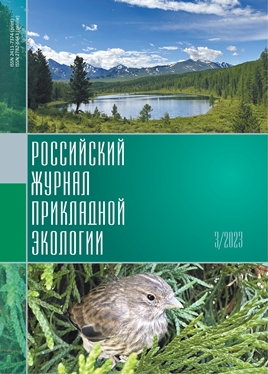Productivity trends of agricultural and forest landscapes in Belarussian Polesia in 2000-2022 (according to the MODIS Terra Data)
DOI:
https://doi.org/10.24852/2411-7374.2023.3.28.33Keywords:
landscape, NDVI, trend, MODIS, climate change, Belarusian PolesiaAbstract
The purpose of this work is to analyze the long-term dynamics of NDVI in agricultural and forest landscapes of the Belarusian Polesia as a response to global changes). Changes in climate and land use in test areas in 2000–2022 were studied. An analysis and assessment of the statistical significance of NDVI trends in agricultural and forest landscapes were carried out. A positive correlation of NDVI of agricultural landscapes with summer precipitation was found (correlation coefficient 0.27); NDVI of forest landscapes is positively correlated with mean annual and summer temperatures (correlation coefficients are 0.15 and 0.26, respectively). A positive correlation has been established between the NDVI of forest landscapes and the content of CO2 in the atmosphere; in agricultural landscapes, there is no correlation between NDVI and CO2 content.
References
Gusev A.P. Izmeneniya NDVI kak indikator dinamiki ekologicheskogo sostoyaniya landshaftov (na primere vostochnoy chasti Polesskoy provintsii) [Changes in NDVI as an indicator of the dynamics of the ecological state of landscapes (on the example of the eastern part of the Polessky province)] // Vestnik Voronezhskogo gosudarstvennogo universiteta. Seriya: Geografiya. Geoekologiyа [Bulletin of the Voronezh State University. Series: Geography. Geoecology]. 2020. No 1. P. 101–107. https://doi.org/10.17308/geo.2020.1/2667.
Gusev A.P. NDVI kak indikator klimatogennykh reaktsiy geosistem (na primere yugo-vostoka Belarusi) [NDVI as an indicator of climatogenic responses of geosystems (on the example of the southeast of Belarus)] // Regional'nyye geosistemy [Regional geosystems]. 2022. Vol. 46, No 2. P. 200–209. doi: 10.52575/2712-7443-2022-46-2-200-209.
Gusev A.P. Otsenka riska negativnykh klimatogennykh reaktsiy polesskikh landshaftov [Assessing the risk of negative climatogenic reactions in Polesia landscapes] // Rossiyskiy zhurnal prikladnoy ekologii [Russian journal of applied ecology]. 2022a. No 4. P. 13–19. https://doi.org/10.24852/2411-7374.2022.4.13.19.
Danilovich I.S., Melnik V.I., Geyer B. Modern climate changes in the Belarusian Polesie: cause, consequences, forecasts [Sovremennyye izmeneniya klimata Belorusskogo Poles'ya: prichina, sledstviya, prognozy] // Zhurnal Belorusskogo gosudarstvennogo universiteta. Geografiya. Geologiya [Journal of the Belarusian State University. Geography. Geology]. 2020. No 1. P. 3–13. https://doi.org/10.33581/2521-6740-2020-1-3-13.
Dronin N.M., Telnova N.O., Kalutskova N.N. Analiz mnogoletnikh trendov produktivnosti agrolandshaftov yuga Vostochnoy Yevropy po materialam distantsionnogo zondirovaniya [Analysis of long-term trends in the productivity of agricultural landscapes in the south of Eastern Europe based on remote sensing data] // Geopolitika i ekogeodinamika regionov [Geopolitics and ecogeodynamics of regions]. 2014. Vol. 10, No 1. P. 529–538.
Martsinkevich G.I. Landshaftovedeniye [Landscape science]. Minsk: BSU, 2007. 206 p.
Melnik V.I., Danilovich I.S., Kuleshova I.Yu., Komarovskaya E.V., Melchakova N.V. Otsenka agroklimaticheskikh resursov territorii Belarusi za period 1989-2015 gg. [Assessment of agroclimatic resources of the territory of Belarus for the period 1989-2015] // Prirodnyye resursy [Natural resources]. 2018. No 2. P. 88–101.
Box E.O., Holben B.N., Kalb V. Accuracy of the AVHRR Vegetation Index as a predictor of biomass, primary productivity and net CО2 flux // Vegetatio. 1989. Vol. 80. P. 71–89.
Gusev A.P. Impact of climate change on ecosystem productivity of the Belarusian Polesia according to remote data // Contemporary problems of ecology. 2022. Vol. 15, No 4. P. 345–352. doi: 10.1038/NCLIMATE3004.
Hao L., Kunxi L., Xiang Z., Jiacheng Z. Changes in vegetation greenness and their influencing factors in Southern China // Remote sensing. 2022. Vol. 14. P. 1–18. doi: 10.1134/S1995425522040060.
Yengoh G.T., Dent D., Olsson L., Tengberg A.E., Tucker C.J. The use of the Normalized Difference Vegetation Index (NDVI) to assess land degradation at multiple scales: a review of the current status, future trends, and practical considerations. Lund University Centre for Sustainability Studies LUCSUS, 2014. 80 p.

Downloads
Published
How to Cite
Issue
Section
License

This work is licensed under a Creative Commons Attribution-NonCommercial 4.0 International License.




